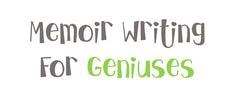Struggling with your memoir?
|
|
|
If you want to get me riled up, just mention the phrase, "Show, don't tell." Why? Because I've seen so many writers use this advice to make their writing worse.
It’s not that this advice is wrong. It’s that it is misinterpreted by nearly everyone who espouses it. One example I often hear is “Don’t tell us what a character is feeling. Instead, you need to show us.” But is that really the best way to get emotion across? Is showing a character’s angry expression and aggressive gestures the best way to help put your reader there with you? To help you understand why "show, don't tell," is advice that isn’t very helpful, let me give you three short writing samples. Don't worry about whether the text is showing or telling; simply think about which one you like best: Sample 1: "Maya was angry." Sample 2: "I hate you!" screamed Maya, throwing a jar of grape jam against the wall, which shattered on the floor with a crash. Sample 3: "I could tell Maya was mad. But I also knew that this anger would fade. An hour from now, she would curl up with me on the couch and offer me warm buttered popcorn as an apology. But for now, I had to let her rage. Otherwise, it would seep and fester, and she would wind up giving me the silent treatment for days." If you only got to pick one of these samples to include in your book, I imagine you'd pick number three. What I want you to notice is that there is no showing in this sample. The writing isn't describing Maya’s anger or giving me a visual sense of how her anger manifests itself. Instead, the writer lets us know how she feels about Neeta's anger. In short, the third sample is all telling. Now, let's talk about why sample three works to pull a reader in. It has to do with the difference between subjective writing and objective writing. Objective writing describes what a person sees or hears -- in fact, it's what anyone who happened to be there would describe. It could include what a character is wearing, what the room looks like, or what the narrator is doing. Subjective writing, on the other hand, is what a narrator thinks or feels. I like to think of subjective writing as "putting us inside the narrator's head." And it's this subjective writing that creates an emotional experience for the reader. Why is number three the strongest writing sample? Because it works to affect a reader emotionally. If I had to choose between "showing" and "telling," I'd pick "telling" every time. Telling is pretty much synonymous with subjective writing, which is what works to make your prose rich and engaging, what works to pull your reader in. If you’d like more information on subjective writing and how to use it to make the prose in your book rich and affecting, check out this video: https://www.youtube.com/watch?v=EuYLebMDJhE Wishing you lots of happy writing.
0 Comments
Leave a Reply. |
AuthorA Random House author offers tips on writing your own memoir. Archives
July 2024
Categories |
|
|
Memoir Writing for Geniuses.
All rights reserved. |

 RSS Feed
RSS Feed